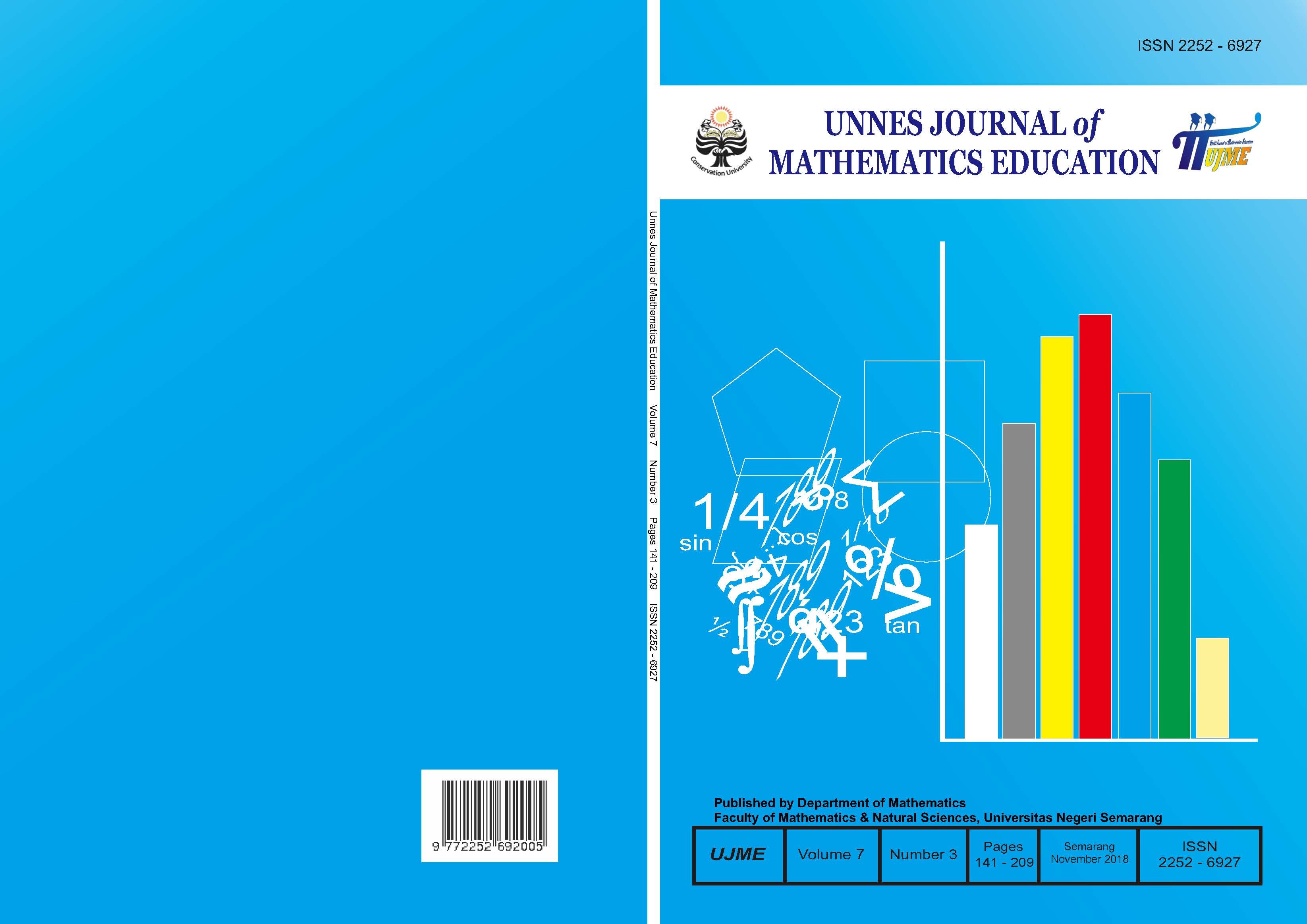Enhancing mathematical problem solving ability through model eliciting activities
##plugins.themes.academic_pro.article.main##
Abstract
The main purpose of this research was to comprehensively examine the achievement and improvement of mathematical problem solving ability through the use of Model Eliciting Activities and Problem Based Learning. The research method used was explanatory sequential mixed methods. The research design used was Pretest-Posttest Control Group Design. The research population was grade VII students one of Junior High School in Kudus except students in the favourite class. The sample was taken by simple random sampling technique, so that grade VII F was obtained as experiment class and grade VII E as control class. Qualitative research subject were taken 6 subjects based on the mathematical early ability category. The result of the research showed that (1) the achievement of mathematical problem solving ability of the students who got Model Eliciting Activities had not reach the completeness classically; (2) the achievement and improvement of mathematical problem solving ability of the students who got Model Eliciting Activities were better than the students who got Problem Based Learning; (3) the students who got Model Eliciting Activities tend to be active and brave rather than the students who got Problem Based Learning; and (4) some of the students’ difficulties, students with the high early mathematical ability in the experiment class did not face any difficulties, only the students were not careful in calculating, while in the control class faced the difficulty in making plans at number 4, thus influencing the next indicator. For students with the medium early mathematical ability in the experiment class faced the difficulty in determining the correctness of the answer and were not careful in calculating, while in the control class faced the difficulty in determining the correctness of the answer and making the plan at number 4 thus influencing the next indicator. Lastly, for students with low early mathematical ability in both experiment class and control class, they faced the difficulty in determining the truth of the answer and had not finished working on the four questions because the time provided has been exhausted.
##plugins.themes.academic_pro.article.details##
References
Chamberlin, S. A. and Moon, S. M. 2008. How Does the Problem Based Learning Approach Compare to the Model-Eliciting Activity Approach In Mathematic?. International Journal For Mathematics Teaching Teaching and Learning. 9(3). 78-105. Tersedia di http://cimt.playmouth.ac.uk (diakses pada tanggal 19 Juni 2017).
Creswell, J. 2016. Research Design Pendekatan Metode Kualitatif, Kuantitatif, dan Campuran Edisi 4 (terj). Yogyakarta: Pustaka Pelajar.
Indonesia, P. R. 2003. Undang-undang Republik Indonesia nomor 20 tahun 2003 tentang sistem pendidikan nasional.
NCTM. 2000. Principles and Standards for School Mathematics. Reston: The National Council of Theachers of Mathematics, Inc.
Permendikbud, R. I. Nomor 65 Tahun 2013. Lampiran III Tentang Struktur Kurikulum, Kompetensi Intikompetensi Dasar, Dan Pedoman Implementasi Kurikulum 2013 Pendidikan Khusus. Jakarta: Depdiknas.
Polya, G. 1973. How To Solve It. Princenton: Princenton University Press. Tersedia di https://notendur.hi.is/hei2/teaching/Polya_HowToSolveIt.pdf (diakses pada tanggal 23 Juni 2017).
Sholikhah, U. 2014. Penerapan Model Eliciting Activities (Mea) Sebagai Upaya Meningkatkan Kemampuan Pemecahan Masalah Dan Disposisi Matematis Siswa Kelas Ix B M.Ts. Taris Lengkong Batangan Pati Materi Pokok Bangun Ruang Sisi Lengkung Tahun Pelajaran 2014/2015. Skripsi. Semarang: IAIN Walisongo.
Stephens, M., Landeros, K., Perkins, R., & Tang, J. H. 2016. Highlights from TIMSS and TIMSS Advanced 2015: Mathematics and Science Achievement of US Students in Grades 4 and 8 and in Advanced Courses at the End of High School in an International Context. NCES 2017-002. National Center for Education Statistics.
Sumarmo, U. 2010. Berpikir logis, kritis, kreatif dan Budipekerti, Apa, Mengapa dan Bagaimana Dikembangkan Pada Siswa. Bandung: Fakultas Pendidikan Matematika dan Ilmu Pengetahuan Alam Universitas Pendidikan Indonesia Bandung.
Yu, S. Y., & Chang, C. K. 2009. What Did Taiwan Mathematics Teachers Think of Model- Eliciting Activities and Modeling?. Trends in teaching and learning of mathematical modelling international perspectives on the teaching and learning of mathematical modeling. 147-156.
